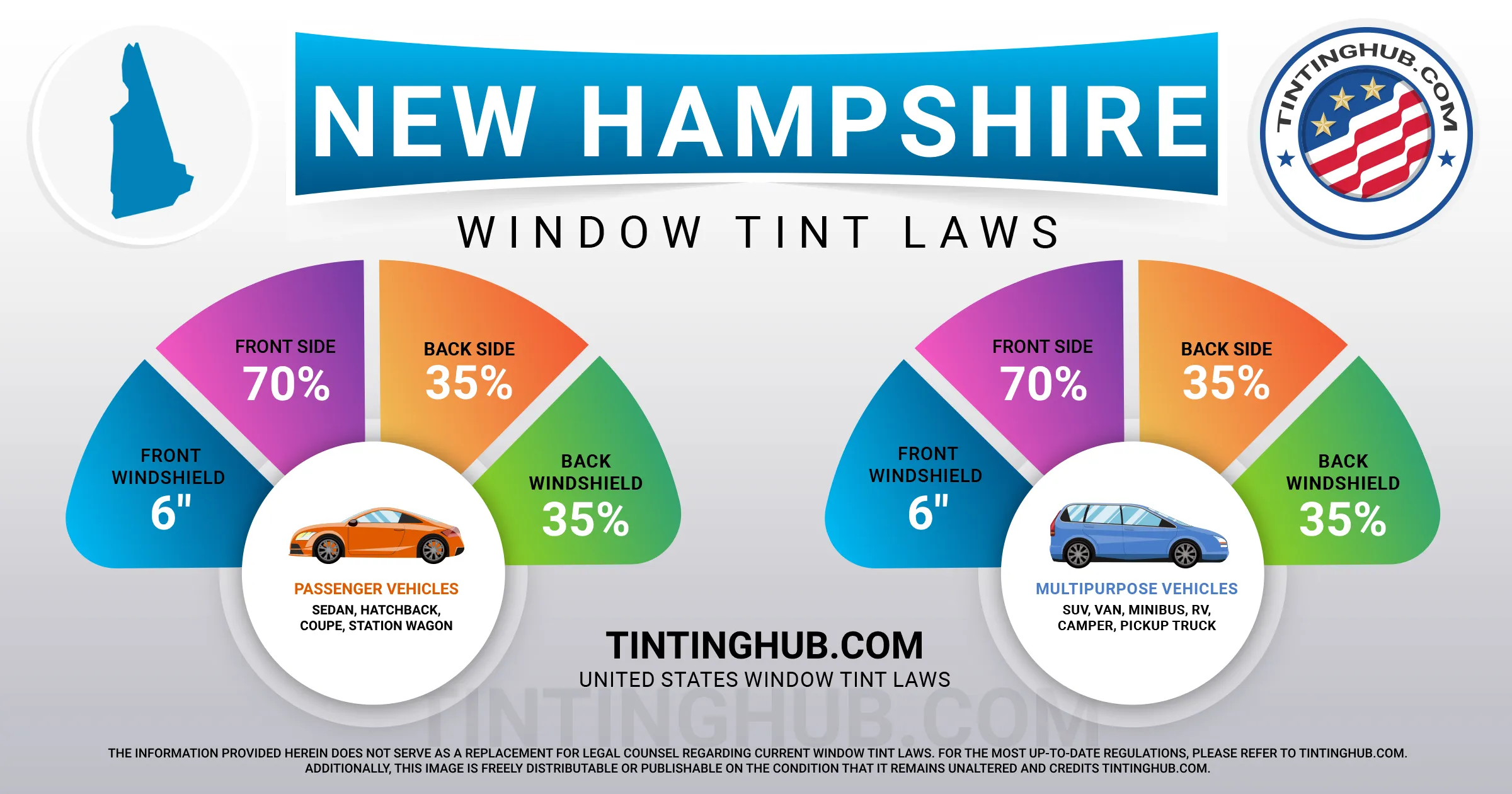New Hampshire Window Tint Laws (Last Update 2024)

Car window tinting regulations in New Hampshire were introduced back in 1990, aimed at maintaining safety and visibility while enhancing privacy. In this article, we’ll provide you with comprehensive insights into New Hampshire’s window tinting laws, ensuring you’re well-informed about the permitted levels of darkness and reflectivity.

Deciphering Tint Darkness in New Hampshire
The degree of visible light allowed through your car windows is referred to as VLT, or Visible Light Transmission. New Hampshire has stringent regulations that vary for sedan cars and SUVs or vans. Let’s break down the specifics:
Tint Darkness for Sedans
- Windshield: A non-reflective tint with 35% VLT is permitted on the top 6 inches of the windshield.
- Front Side Windows: These windows must allow more than 70% of light to pass through.
- Back Side Windows: The law mandates that more than 35% of light should be allowed in.
- Rear Window: Similar to back side windows, the rear window should also allow more than 35% of light.
Tint Darkness for SUVs and Vans
- Windshield: Just like sedans, non-reflective tint with 35% VLT is allowed on the top 6 inches of the windshield.
- Front Side Windows: For SUVs and vans, they must also permit more than 70% of light to pass through.
- Back Side Windows: Again, similar to sedans, more than 35% of light should be allowed.
- Rear Window: The rear window for SUVs and vans should have a minimum VLT of 35%.
It’s important to note that New Hampshire updated its legislation in 2021, allowing a 70% VLT on front side windows. For more details, you can refer to House Bill 224.
Exploring Tint Reflection Regulations
Window tint isn’t just about darkness; it can also reflect incoming light, reducing glare and heat. In New Hampshire, the law provides guidelines for permissible window tint reflection:
Tint Reflection for Sedans
- Front Side Windows: These windows should not exhibit a metallic or mirrored appearance.
- Back Side Windows: Similar to front side windows, back side windows should also not have a metallic or mirrored appearance.
Tint Reflection for SUVs and Vans
- Front Side Windows: For SUVs and vans, just like sedans, metallic or mirrored appearance is not allowed on front side windows.
- Back Side Windows: Back side windows for SUVs and vans should also avoid metallic or mirrored appearance.
Additional New Hampshire Window Tint Regulations
New Hampshire has several other essential laws and regulations related to window tinting:
- Side Mirrors: Dual side mirrors are only required if the back window is tinted.
- Restricted Colors: The law doesn’t explicitly restrict the colors of tint.
- Certificates: Manufacturers of window film do not need to certify their products in New Hampshire.
- Stickers: While state law recommends using stickers to identify legal tinting, it’s not a strict requirement.
- Medical Exceptions: New Hampshire law allows medical exemptions for a 35% VLT on the windshield and windows to the left and right of the driver.
Understanding Penalties
Violating these tinting laws in New Hampshire is considered a non-moving traffic violation. To avoid any legal issues, it’s essential to comply with the regulations.
Keep in mind that New Hampshire’s tinting laws and regulations may be interpreted differently depending on your county or place of residence. Therefore, it’s always a good practice to double-check the information with your local DMV or law enforcement authorities.
Stay Updated
Our information regarding window tint laws in New Hampshire is current as of 2023. However, laws can change, so if you find any information that needs updating or correcting, please feel free to reach out to us. We strive to be your trusted source for accurate and up-to-date window tinting laws in the state.